The headline is the most important part of the story. In fact, statistics say that on average, 8 out of 10 people read headline copy, compared to 2 out of 10 who read the rest of the story. Headlines grab, shock, educate and entertain us. Used wisely they draw us in to the greater narrative giving us the opportunity to explore more of the story. But in many cases, the headline, whether it’s for an article or for your LinkedIn profile, is an afterthought.
Your LinkedIn headline draws people into your professional story, your Profile. Whether you are in search of a new job or are perfectly happy where you are, spend some time on your LinkedIn headline. Make it a priority. It is the piece that will either make people read more or move on.
What should be in your LinkedIn headline?
You have 120 characters so move beyond your job title in your headline. People want to know about you–your best qualities, skills and strengths, not just your title. So, no problem if you are an emerging professional (a graduating student) or in career transition (without a current job). Use your headline to draw people into your profile. Trust me, your job title–or lack thereof–will not be compelling to many people. And whatever you do, don’t leave your headline blank. That’s the best way to get passed over.
In a post by Rick Moran titled Behind the Dismal Jobs Numbers: The ‘New’ Economy Takes Shape, he mentions that nearly 10% of today’s workforce is what the BLS (Bureau of Labor Statistics) calls “employed part-time for economic reasons.” He continues to say, ” That is to say, either their hours were cut or they were forced into part-time work because they couldn’t find full-time employment. According to Gallup, the percentage of part-time workers who want full-time work but can’t find any is the same as it was in March 2012.”
Employed part-time for economic reasons may be just the right type of LinkedIn headline. It’s clear, it infers you are not satisfied with unemployed or part-time work, and it is clear and honest. I think hiring managers prefer this to someone who is jockeying semantics and trying to marginalize their current employment status.
If you are in ‘career transition,’ don’t use ‘unemployed’ in your LinkedIn headline. It’s a downer in my opinion. It’s the past and sounds pessimistic. It’s important to sound optimistic. Seeking, in search of, transitioning are all are more forward-sounding.
A few tips to create a quality LinkedIn headline (create the variation that works for you)
- Take your LinkedIn profile/resume or a job description and create a word cloud to find/notice the keywords that show up. Are they accurate and do the keywords that you find in the job description match up with what’s on your Profile or in your resume? They need to.
- Include three or four keywords that best represent you and put them into your headline and your LinkedIn Profile.
- Client Development | Focus on Lead Generation & Inbound Marketing
- Client Development | Focus on Account Management & Customer Service
- Include an outcome phrase in your LinkedIn headline.
- Protecting Client’s Financial Assets
- Delivering IT Services for Small to Mid-Sized Companies
- Employed Part-Time for Economic Reasons
- Seeking (define specific type) New Opportunities (ie. Seeking New Opportunities in IT | Systems Administration, Seeking New Opportunities in Direct Mail Marketing, Seeking New Opportunities in Operations).
- Use all or as many of the 120 characters as possible in your LinkedIn headline. Write it, test it, tweak it. Your LinkedIn headline is not necessarily a fixed element of your Profile especially if you are in transition or emerging.
- Be creative. Lots of people are ‘experienced pet sitters.’ But are you a: ‘Reliable pet-sitter who will find out and report back to you exactly what your dog is up to when you’re not home‘
- Look at who is viewing your Profile and notice the keywords (depending on your level of LinkedIn membership) that have been used to find you.
By all means, if you have spent some time and created a great headline for yourself, follow through and address all areas of your profile, making sure it’s 100% complete. A U.S. News and World Report article states that 50 percent of Fortune 100 companies hire using LinkedIn. Want your profile to be found? Start with your LinkedIn headline.
If you want even more perspective on our new economy and how we now need to view our careers, pick up or download, The Start-up of You. I refer to this book over and over simply because it’s a blueprint for the new career mindset.
Let us know how you created your LinkedIn headline, what’s working for you?



